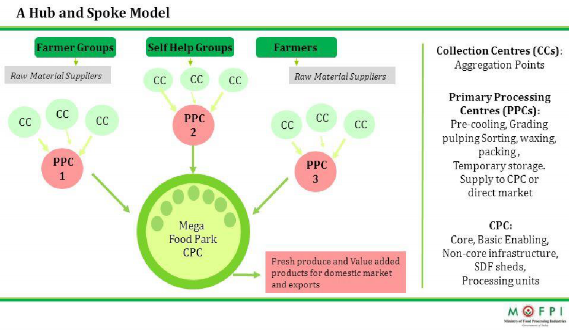♤ Mega Food Parks Scheme
The idea behind setting up of mega food parks is that small and medium entrepreneurs find it difficult to invest in capital-intensive activities. It aims at providing a mechanism to link agricultural production to the market by bringing together farmers, processors and retailers so as to ensure maximizing value addition, minimizing wastage, increasing farmers’ income and creating employment opportunities particularly in rural sector
Mega food park typically consist of supply chain infrastructure including collection centers, primary processing centers, central processing centers, cold chain and around 30-35 fully developed plots for entrepreneurs to set up food processing units.
Common facilities include cold storage, food testing and analysis lab, affluent treatment plant, common processing facilities, packaging centre, power supply, water supply, seminar/ conference / training facilities etc.
The Mega Food Park Scheme is a “Cluster” approach on Hub and Spoke model. It envisages creation of state of art support infrastructure in a well-defined agri / horticultural zone for
setting up of modern food processing units in the industrial plots provided in the park with well-established supply chain.
This cluster approach makes food processing more economically viable. The state-of-the art processing infrastructure gives them the required technical edge. Mega Food parks have the potential to revive the agriculture in the surrounding areas by increasing returns for farmers, besides creating large employment opportunities in rural areas.
The Mega Food Park project is implemented by a Special Purpose Vehicle (SPV) which is a Body Corporate registered under the Companies Act. State Government, State Government entities and Cooperatives are not required to form a separate SPV for implementation of Mega Food Park project.

Despite continual efforts and initiatives of the Government to provide the required stimulus to the sector, processing activity is still at a nascent stage in India with low penetration. The level of processing is currently low across the product categories.
